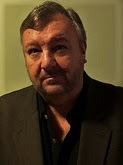Ben Macintyre (seen in the below photo), the author of The Spy and the Traitor: The Greatest Espionage Story of the Cold War, A Spy Among Friends: Kim Philby and the Great Betrayal, and other fine books on spies and espionage, wrote a good column for the London Times on Russian dictator Vladimir Putin’s use of assassination.
The
column also appeared in the Australian.
In Russian spy jargon, an assassination hit squad is known as a “Mercader”, after Ramon Mercader, the Spanish communist agent who buried an ice pick in Leon Trotsky’s head as he sat in his study in Mexico City. Mercader was declared a “Hero of the Soviet Union” on his release from prison 20 years later.
Today, Russia’s “Mercaders” are off the leash across the world: from the “Polar Wolf” gulag in the Russian Arctic, where the opposition leader Alexei Navalny was murdered last week, to the underground garage near Benidorm where the bullet-riddled body of the Russian defector Maxim Kuzminov was found a few days earlier.
The weapons deployed for traditional Russian “wet work” (mokroye delo) have changed over time: the ice pick that killed Trotsky and the poisoned umbrella tip that saw off the Bulgarian dissident Georgi Markov have given way to polonium (Alexander Litvinenko), novichok nerve agent (Sergei Skripal), the plunge from the balcony that ends the lives of so many of Vladimir Putin’s critics and enemies, or the spectacular air explosion that immolated the Wagner mercenary Yevgeny Prigozhin.
Navalny may have been killed by the notorious “KGB punch”, a lethal blow to the heart administered to a person already enfeebled by cold.
But the idea remains the same: a theatrical symbolic act of state-sponsored homicide, to send a warning to other would-be opponets, cow the Russian populace and stun the world with its brazen brutality, all suffused with just enough mystery for a shrugging Kremlin denial.
Stalin saw assassination as integral to his foreign policy, the external expression of the Great Terror: dissidents, defectors, spies, ideological heretics, all were potential targets. In 1942 the military intelligence section of the Red Army established a specialised unit to liquidate “anti-Soviet elements”.
Stalin named it Smersh, merging the Russian words smert meaning death and shpionam meaning spies: “death to spies”. As a wartime intelligence officer, Ian Fleming learnt of Smersh, and incorporated it into his James Bond novels.
Putin has gone still further in performative, staged acts of murder. The killings are now preceded by a statement of the assassin’s philosophy, the promise of revenge.
You
can read the rest of the column via the below link:
Note: I quoted Ben Macintyre in my Washington Times review of From Russia With Blood:
“If the idea of a ruthless spy-killing unit sounds like the
stuff of fiction, that’s because it became precisely that,” Ben Macintyre wrote
in his Times column. “In the James Bond novels, Ian Fleming portrayed Smersh
(director of operations: Rosa Klebb) as a massive counterintelligence network
that more closely resembled the KGB.”
Ben Macintyre wrote that the real SMERSH was effective in not only
murdering Soviet traitors (some of whom were undoubtedly innocent, he noted),
but SMERSH also instilled terror among potential enemies and enforced obedience
in Soviet citizens.
“And now it is back, with a new name and a new remit but
essentially the same purpose: to put the fear of God, and assassination,
into Russia’s enemies, traitors and deserters,” Mr. Macintyre
wrote. “According to intelligence sources, Unit 29155 is an elite sub-unit of
GRU assassins that operated out of the Haute-Savoie in the French Alps,
conducting a variety of wet jobs across Europe: notably the attempted poisoning
in Salisbury of GRU officer-turned-MI6 spy Sergei Skripal, and the attempt to
kill a Bulgarian arms dealer in 2015.”
In Ian Fleming’s classic 1957 thriller "From Russia With
Love,” James Bond was the target of a SMERSH plot to assassinate him and
discredit British intelligence in a scandal. SMERSH sent out from Russia a
psychopath assassin named Red Grant to kill Bond. Ian Fleming admitted that his
plots were fantastic, but he also said they often lifted the tip of the veil to
reveal the real world of espionage.
Heidi Blake’s “From Russia With
Blood” (a clever take on Ian Fleming’s “From Russia With
Love” title), lifts the veil off a series of murders in the United Kingdom and
places blame squarely on Russian leader Vladimir Putin.
You
can read the rest of the piece via the below link:





No comments:
Post a Comment